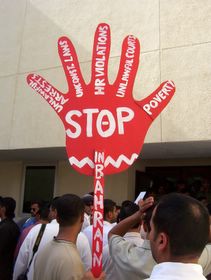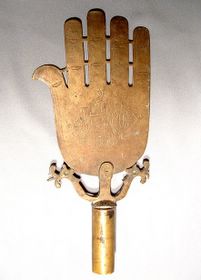Political aspects of Ashura
Monday, March 07, 2005I was planning on writing about the political aspects of Ashura in a separate post, but since the subject has been raised in the newspapers today, I'll do it now. The frontpage headline story of today's GDN reads:
LAWBREAKERS WARNEDMANAMA: Bahrain vowed yesterday to crack down on lawbreakers who threaten national unity.It will not tolerate sectarian acts, declared Interior Minister Shaikh Rashid bin Abdulla Al Khalifa. He briefed the Cabinet and also held an urgent meeting with National Assembly members over violations committed during Ashoora. [...] He said some people abused Ashoora to spread hate messages through chanting slogans and hanging posters, which called for division between community members. (Continued)
My initial response to this statement is that if the government is serious about cracking down on sectarianism, then it should start by ending its own sectarianist policies which fuels sectarianism throughout society.
But I'm not too sure what exactly brought on this statement by the government. I was in Manama during the Hussaini processions for five of the ten nights leading up to Ashura, but I did not encounter any of the "hate messages" that called for "division between community members". That doesn't mean that it did not contain any political messages though. The Committee for Martyrs and Victims of Torture and the Committee for the Unemployed both had separate stalls along the main procession route where they displayed videos and distributed information about their respective causes. The BCHR report about discrimination was apparently discussed in many of the matam lectures. I saw several posters pasted on the walls along the procession routes demanding the repeal of Royal Decree 56. And on Diraz roundabout were displayed portraits of some of the village's youths who were killed by the state "security" forces during the 1990s uprising:

Those portraits gave a contemporary tinge to the black flags hung nearby that had "Ya Shaheed" ("O martyrs") printed on them.
But I think it is important to point out that there has always been something very political about Ashura. The Tragedy of Karbala is itself a story of the righteous taking a stand against the oppressors, and the commemoration of Ashura is a form of protest against what happened. In an essay titled "Red Shi'ism vs Black Shi'ism", the Iranian sociologist (and progressive Islamist) Dr Ali Shariati writes in unambiguous terms:
Remember Ashura, to humiliate the ruling group who call themselves the inheritors of the traditions of the Prophet, for the remembrance of it will prove that they are the inheritors of the killers and murderers of the Prophet's family. It will show you a path of action, and provide an answer to the recurring question "What should be done?". It will help you to decide on the best agenda for the struggle against the rule of tyranny. It will avoid allegiance to cruelty. It will provide a pattern for the unbroken continuity of history. It will declare an unending struggle between the inheritors of Adam and the inheritors of the devil.
In Bahrain this has certainly been the case historically, with the Ashura processions being a sign of solidarity of the Shia against the ruling clan. Moreover, not only do the Hussaini processions contain an element of politics, but so to do political demonstrations in Bahrain borrow elements from the Hussaini processions. Sometimes azza music is played on the loudspeakers, and chants of "ma3kum ma3kum ya 3ulema" ("we are with you, o learned ones") are very common. Or even take for example this sign that was used in one of the demonstrations during the Al-Khawaja affair:

Maybe I'm reading too deep into this, but to me that sign bears a resemblance to the hand-shaped finial standards that are carried around in the Ashura processions:

Photo source: here
While certainly many of the demonstrators in Bahrain are religiously motivated, I think it is also the case that the form of the Ashura processions serve as a template for other types of demonstrations. For many people in Bahrain, the Ashura processions are the form of protest that they are most familiar with, which is why we see its traits elsewhere.
Bahrain is by no means the only place in the world where Ashura has taken on political connotations. One of the most interesting cases is in Trinidad which hosts a small Indian Shia community. It is reported that Ashura, known locally as "Hosay", has been commemorated in Trinidad since 1846. According to an article titled Muharram Rituals and the Carnivalesque (ISIM Review, July 1999, pg 38) by Gustav Thaiss
The Muharram rituals quickly became the main symbol of Indian nationalism in the face of British colonialism and of a sense of identity vis--vis Indian minority status in the Black Caribbean. Despite their differences, however, the Creoles, Indians and others joined together in the Hosay processions to protest various injustices, including the reduction of wages on the plantations and the concomitant increase in workload. It has even been said that the Hosay gave symbolic form to a growing working-class consciousness throughout the Caribbean. Such activities began to cause anxiety because of the allegedly increasing tendency to riotous behaviour. Throughout the 19th century, great alarm was expressed by British authorities and other colonists over the threat to public order of the Muharram rituals (as well as Carnival celebrations) culminating in the Hosay massacre of 1884 (referred to by the British as the 'Coolie Disturbances in Trinidad').
(Read the entire article, it is fascinating. For more about Hosay read this and this.) I'm sure you can draw some interesting parallels with Bahrain.
Alright, this post was going to have a conclusion but I'm lost. Maybe some of you readers (especially the Shia ones) could provide some better insight.

3/10/2005 01:30:00 am
The "threes" are used to represent the Arabic letter "ayn" (ﻉ). It's a bit difficult to explain how it sounds in writing. It's a voiced letter that's made with the root of your tongue in your through. Try googling for a better explanation :)
Hope you're doing well down under!